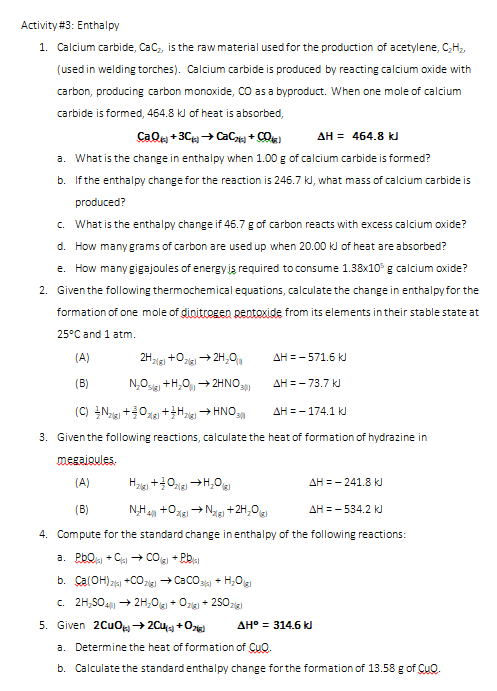Activity#3: Enthalpy 1. Calcium carbide, CaC, is the raw material used for the production of acetylene, C,H, (used in welding torches). Calcium carbide is produced by reacting calcium oxide with carbon, producing carbon monoxide, CO as a byproduct. When one mole of calcium carbide is formed, 454.8 kl of heat is absorbed, CaQa +3C+ CaC + CO AH = 464.8 kJ
Activity#3: Enthalpy 1. Calcium carbide, CaC, is the raw material used for the production of acetylene, C,H, (used in welding torches). Calcium carbide is produced by reacting calcium oxide with carbon, producing carbon monoxide, CO as a byproduct. When one mole of calcium carbide is formed, 454.8 kl of heat is absorbed, CaQa +3C+ CaC + CO AH = 464.8 kJ
Introduction to Chemical Engineering Thermodynamics
8th Edition
ISBN:9781259696527
Author:J.M. Smith Termodinamica en ingenieria quimica, Hendrick C Van Ness, Michael Abbott, Mark Swihart
Publisher:J.M. Smith Termodinamica en ingenieria quimica, Hendrick C Van Ness, Michael Abbott, Mark Swihart
Chapter1: Introduction
Section: Chapter Questions
Problem 1.1P
Related questions
Question

Transcribed Image Text:Activity #3: Enthalpy
1. Calcium carbide, Cac, is the rawmaterial used for the production of acetylene, C,H,,
(used in welding torches). Calcium carbide is produced by reacting calcium oxide with
carbon, producing carbon monoxide, CO as a byproduct. When one mole of calcium
carbide is formed, 454.8 kl of heat is absorbed,
CaOe +3C → CaCe + COs)
AH = 464.8 kJ
a. Whatis the change in enthalpy when 1.00 g of calcium carbide is formed?
b. If the enthalpy change for the reaction is 245.7 kl, what mass of calcium carbide is
produced?
c. What is the enthalpy change if 45.7 g of carbon reacts with excess calcium oxide?
d. How manygrams of carbon are used up when 20.00 kJ of heat are absorbed?
e. How manygigajoules of energyis required to consume 1.38x10 g calcium oxide?
2. Given the following thermochemical equations, calculate the change in enthalpy for the
formation of one mole of gipitrogen pentoxide from its elements in their stable state at
25°C and 1 atm.
(A)
2Halej +0la → 2H,0
AH = - 571.6 kJ
(B)
N,0 +H,0 + 2HNO
AH = - 73.7 kJ
sg)
(C) N +01e +H+ HNO,
AH = - 174.1 kJ
3. Given the following reactions, calculate the heat of formation of hydrazine in
megaioules.
(A)
+
AH = - 241.8 kJ
(B)
+0%g → Ng +2H,0
AH = - 534.2 kJ
4. Compute for the standard change in enthalpy of the following reactions:
a. Pbo + C → CO + Pb
b. Ça(OH)z +co + Cacoala + H,0
c. 2H,SO4 + 2H,0g + Ozk + 250zig)
5. Given 2CuO+ 2Cu +0,
AH° = 314.6 kl
a. Determine the heat of formation of Cuo.
b. Calculate the standardenthalpy change for the formation of 13.58 g of Cuo.
Expert Solution
This question has been solved!
Explore an expertly crafted, step-by-step solution for a thorough understanding of key concepts.
This is a popular solution!
Trending now
This is a popular solution!
Step by step
Solved in 4 steps with 6 images

Knowledge Booster
Learn more about
Need a deep-dive on the concept behind this application? Look no further. Learn more about this topic, chemical-engineering and related others by exploring similar questions and additional content below.Recommended textbooks for you

Introduction to Chemical Engineering Thermodynami…
Chemical Engineering
ISBN:
9781259696527
Author:
J.M. Smith Termodinamica en ingenieria quimica, Hendrick C Van Ness, Michael Abbott, Mark Swihart
Publisher:
McGraw-Hill Education

Elementary Principles of Chemical Processes, Bind…
Chemical Engineering
ISBN:
9781118431221
Author:
Richard M. Felder, Ronald W. Rousseau, Lisa G. Bullard
Publisher:
WILEY

Elements of Chemical Reaction Engineering (5th Ed…
Chemical Engineering
ISBN:
9780133887518
Author:
H. Scott Fogler
Publisher:
Prentice Hall

Introduction to Chemical Engineering Thermodynami…
Chemical Engineering
ISBN:
9781259696527
Author:
J.M. Smith Termodinamica en ingenieria quimica, Hendrick C Van Ness, Michael Abbott, Mark Swihart
Publisher:
McGraw-Hill Education

Elementary Principles of Chemical Processes, Bind…
Chemical Engineering
ISBN:
9781118431221
Author:
Richard M. Felder, Ronald W. Rousseau, Lisa G. Bullard
Publisher:
WILEY

Elements of Chemical Reaction Engineering (5th Ed…
Chemical Engineering
ISBN:
9780133887518
Author:
H. Scott Fogler
Publisher:
Prentice Hall


Industrial Plastics: Theory and Applications
Chemical Engineering
ISBN:
9781285061238
Author:
Lokensgard, Erik
Publisher:
Delmar Cengage Learning

Unit Operations of Chemical Engineering
Chemical Engineering
ISBN:
9780072848236
Author:
Warren McCabe, Julian C. Smith, Peter Harriott
Publisher:
McGraw-Hill Companies, The